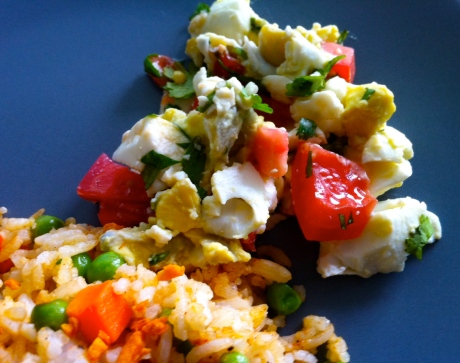
When Rama said she missed sinigang, Poch and I resolved that October 3-7 was going to be a Pinoy Food week for the family. To up the level of difficulty a bit – a challenge I assumed was directed at me – it was also going to be vegetarian. Now, we all know that Pinoy ≠ vegetarian. Even pinakbet, which Filipinos swear is vegetarian, has bits of pork or shrimp in it – pampalasa lang naman, as a friend once argued.
The vegetarian sinigang (Monday) and the kalabasa at sitao sa gata (Tuesday) were easy enough, as we had cooked them fairly often. But vegetarian kare-kare? Sans bagoong, to boot!

Me, Chef Geoff Hopgood, and Mr. Neil. Chef Geoff was the featured chef at my recent birthday party.
My first and last attempt at a vegetarian version was more than a year ago, a dismal failure, with the vegetables ending up mushy and unrecognizable in the peanut sauce.

Chef Geoff's take on Kare-Kare proves it can be served in a beautiful, appetizing way.
Inspired by the kare-kare that Chef Geoff Hopgood prepared for my birthday party, I thought I could do better this time. The secret, as I found out with my oxtail kare-kare, was to blanch the vegetables quickly, throw them in an ice bath and serve them separate from the sauce. But then, Chef Geoff cubed and fried the eggplants – a neat trick, as eggplants and I had been long-time adversaries in the kitchen. Maybe if I treated them special too, they would keep their beautiful purple color and firmness and we could be friends finally. Hence, eggplant slices in panko crust! They turned out visually interesting and, on the taste front, crunchy and flavorful. On my vegetarian kare-kare, they shared star billing with the peanut sauce.
P.S.
Here’s a short note about blanching vegetables: I learned from my mom that adding baking soda in the boiling water helped the vegetables keep their color and crunch. Maybe I’ll try this trick when I don’t have enough time and patience for panko-crusted eggplants. I also added baking soda to the flour to make a firmer, crunchier panko crust, a tip I read somewhere. Hmmm, baking soda… it’s even good for scouring stovetops and kitchen counters.
—————————–
Eggplant in Panko Crust
1 asian eggplant, 1/2-inch diagonal slices
1/2 cup flour combined with 1 tsp of baking soda
1 egg beaten
1/2 cup panko crust
Dip eggplant slices in the flour mix, egg and panko, then fry in canola oil. When slices turn golden brown, transfer to a plate with paper towel to drain. Keep warm.
Peanut sauce
1/2 cup diced onion
1/2 cup diced tomato
2 cloves garlic minced
2 tablespoons canola oil
1 tablespoon peanut butter
1 tablespoon annato oil
1/3 cup roasted unsalted peanuts and toasted rice, finely ground
2-1/2 or 3 cups vegetable broth
Salt and pepper to season
Bagoong, on the side for the non-vegetarians
Saute onion, garlic and tomato. When softened, add peanut butter and stir until smooth. Add broth and the annato oil. Bring to a boil then add the ground peanuts and toasted rice. Lower heat and simmer until sauce is in your desired consistency. Season with salt and pepper.
Blanched Vegetables
Boil about 4 cups water and add a teaspoon of baking soda. Blanch the long beans and baby bokchoy for one minute or less and immediately put in an ice bath or cold water to stop the cooking. Drain and arrange on a platter, with the panko-crusted eggplant slices.
This recipe serves 3.






